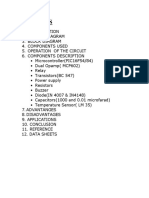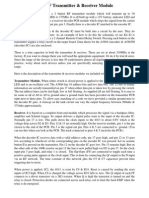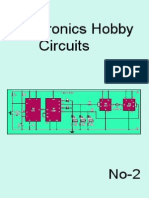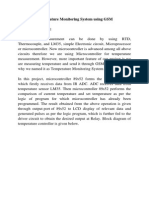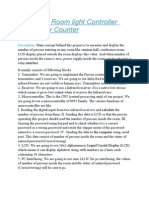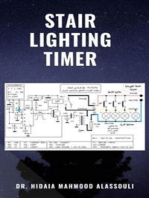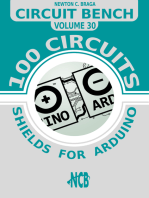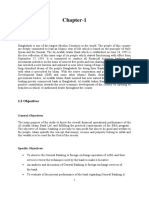Data Transmission Through Power Line
Data Transmission Through Power Line
Uploaded by
nehasingh549Copyright:
Available Formats
Data Transmission Through Power Line
Data Transmission Through Power Line
Uploaded by
nehasingh549Original Title
Copyright
Available Formats
Share this document
Did you find this document useful?
Is this content inappropriate?
Copyright:
Available Formats
Data Transmission Through Power Line
Data Transmission Through Power Line
Uploaded by
nehasingh549Copyright:
Available Formats
Data transmission through power line.
In this project we show that how we transfer the digital data on the power line.. IN this project we use one transmitter circuit and one receiver circuit. In transmitter circuit we use one dtmf generator circuit and in the receiver circuit we use dtmf decoder circuit. With the help of dtmf generator circuit we generate different codes at a time and in the receiver module we receive a different frequency at a time and we use it as a main controller circuit.
In this project we use main power line as a carrier . We use neutral and earth wire as a data transfer line. IN this project main power line is same in the whole line , If the phase is on the left point of the main plug then this should be same for every point in the home. We transfer all the data from the dtmf generator to neutral point in the main line with the help of the high voltage capacitor. On the receiver hand we receive the same data from the neutral line through the .01 high voltage capacitor and then we use dtmf decoder circuit.
In the dtmf generator circuit we use ic um 91214 as a main dtmf signal generator. We use total 12 switches as a input data to the um 91214 and output of the 91214 is connected to the neutral line through .01 capacitor. DTMF CODE GENERATOR CIRCUIT.
In this part of the project we use one dtmf generator ic. We use ic um 91214 ic to generate a dtmf code for different multiple switches,. All the the 12 switches are connecte4d to the ic 91214 ic
we use only 12 keys from this 16 keys matrix. We use 0 to 9 keys and star and hash keys if we require a 12 input keys. But in our project we use only 10 keys for this project operation.
Pin no 6 of the um 91214 is connected to the positive power supply. On this pin we provide a 3 volt power supply so we connect a one zener diode , resistance and capacitor circuit to provide a zener regulation of 3 volt DC. One crystal is connected to the pin no 3 and 4 of the ic um 91214. here we use 3.58 Mhz crystal as a main generator of carrier frequency. All the switches are connected to the um 91214 in the four rows and three .coloum. All the switches are connected in the um 91214 in the matrix formation. Pin no 12, 13 and 14 is connected to the coloum and pin no 15,16,17,18 is connected to the coloum. Output signal is available on the pin no 7 of the ic um 91214 . Output from the dtmf generator is now connected to the power line through .01 capacitor .
Output of the fm receiver is now connected to the 8870 ic. This ic is dtmf decoder ic and dtmf decoder decode the signal and converted into bcd signal.. . Ic 8870 is a single chip dtmf receiver incorporating switches capacitor filter technology and an advanced digital counting averaging alogorithm for period measurement.
Output from the 8870 decoder is further connected to the ic 74154. Ic 74154 is bcd to decimal decoder.
bcd from the 8870 is available on pin no 11,12,13,14 and this output is further connected to the pin no 20,21,22,23 of the ic 74154. Pin no 18 and 19 of the ic 74154 is enable control of the circuit. In our project we connect a one npn transistor to this point. Collector of the npn transistor is connected to the pin no 18 and 19 of the ic 74154 to provide a positive voltage on this point. Pin no 15 of the ic 8870 is a acknowledgement of the dtmf signal, when dtmf signal is available on the pin no 15 then with the help of this dtmf signal we switch on the npn transistor and further npn transistor
provide a negative pulse to the pin no 18 and 19 of the ic 74154 and decimal signal is available on the output pins. Here we use only 10 output of the ic..
Output of the ic 74154 is active low. So to convert this active low output in to active high we use inverter ic. Here we use ic 4049 as a hex inverter and with the help of this hex inverter we convert the active low output in to active high output with the help of inverter logic
Output of the inverter is now positive signal but output of the inverter is still in pulse form. To convert this pulse into on/off signal we require a flip flop circuit . With the help of flip flop circuit we convert the pulse logic into high or low logic with the help of flip flop circuit. Here we use ic 4013 as a flip flop circuit. Output of the flip flop is further connected to the relay driver circuit.
ic 4013 is dual D type flip flop circuit. Pin no 14 is connected to the positive supply and pin no 7 is connected to the negative supply. Pin no 3 and 11 is the clock input pin . Data pin os pin no 9 and pin no 5. Output signal is available on the pin no 13 and pin no 1 of the ic 4013 flip flop.
In this project we use total 5 ic 4013 as a relay driver circuit. With the help of this five flip flop we control total 10 different electrical appliances with the help of the relay driver circuit.
If we want to control the relay with the help of flip flop then we use npn transistor between flip flop and relay circuit . Here transistor work as a switch and with the help of this transistor we switch on/off the relay coil
CIRCUIT DIAGRAM OF TRANSMITTER CIRCUIT.
THE
DATA
RECEIVER CIRCUIT LINE.
AND RECEIVE DATA FROM THE POWER
7805 REGULATED POWER SUPPLY. FOR RECEIVER CIRCUIT. In the receiver circuit we use full wave rectifier with 7805 regulator circuit and in the transmitter circuit we use bridge rectifier circuit with 5volt regulator to regulate the voltage. Two high value capacitor is connected before and after the regulator to reduce the ripple factor of power supply.
CIRCUIT DIAGRAM FOR RECEIVING THE DTMF DATA THROUGH POWER LINE
You might also like
- PWM DC Motor Speed Control Using 555Document16 pagesPWM DC Motor Speed Control Using 555Karthik Dm67% (3)
- GSM Robotic ArmDocument68 pagesGSM Robotic ArmParveen KumarNo ratings yet
- Mini ProjectsDocument55 pagesMini ProjectsSampath KumarNo ratings yet
- Control de Un Motor de CDDocument4 pagesControl de Un Motor de CDAlonso HernandezNo ratings yet
- Mcu Mobile ControlDocument58 pagesMcu Mobile ControlUtkarsh PalNo ratings yet
- Alcohol Detector and ControlDocument10 pagesAlcohol Detector and Controlgourav31iteNo ratings yet
- 555 Timer IC-Block Diagram-Working-Pin Out Configuration-Data SheetDocument13 pages555 Timer IC-Block Diagram-Working-Pin Out Configuration-Data SheetΔημητριος ΣταθηςNo ratings yet
- Smart Parking System: A Major Project ReportDocument62 pagesSmart Parking System: A Major Project ReportNikhil RastogiNo ratings yet
- Automatic Bathroom Light Switch Circuit Diagram AnDocument5 pagesAutomatic Bathroom Light Switch Circuit Diagram Ankhaembas814No ratings yet
- Block Diagram of Infrared Remote Control SwitchDocument4 pagesBlock Diagram of Infrared Remote Control SwitchminthooNo ratings yet
- RF Id Attendence MemoryDocument128 pagesRF Id Attendence Memoryakhilesh thapliyalNo ratings yet
- Remote Controlled Home Loads Using ATmega8Document37 pagesRemote Controlled Home Loads Using ATmega8Anand CoolNo ratings yet
- Clap SwitchDocument14 pagesClap SwitchAkilesh ArigelaNo ratings yet
- Frequency To Voltage Converter ReportDocument5 pagesFrequency To Voltage Converter ReportEssa SiddiquiNo ratings yet
- Light Dependent Resistor LM339 Automatic Lightdark Indicator BC 547Document3 pagesLight Dependent Resistor LM339 Automatic Lightdark Indicator BC 547yeateshwarriorNo ratings yet
- SE/NE 555 Timer. It Is Basically A Monolithic Timing Circuit That Produces Accurate and Highly Stable Time Delays orDocument12 pagesSE/NE 555 Timer. It Is Basically A Monolithic Timing Circuit That Produces Accurate and Highly Stable Time Delays orEFraim Manzano FranciscoNo ratings yet
- Automatic Street LightDocument13 pagesAutomatic Street LightReymark CrisostomoNo ratings yet
- 555-Timer Class NotesDocument1 page555-Timer Class NotesPraveen KumarNo ratings yet
- Unit-3 - Function Generator Using IC 8038Document10 pagesUnit-3 - Function Generator Using IC 8038yp2401553No ratings yet
- 555 Timer IC: The Important Features of The 555 Timer AreDocument5 pages555 Timer IC: The Important Features of The 555 Timer AreChara GalaNo ratings yet
- 5 Channel IR Remote Control System Using MicrocontrollerDocument5 pages5 Channel IR Remote Control System Using MicrocontrollerKoushik MaityNo ratings yet
- Design IdeasDocument10 pagesDesign IdeasElise Phillips100% (2)
- Mini Project Report (CLAP SWITCH)Document22 pagesMini Project Report (CLAP SWITCH)Om Prakash Singh100% (4)
- Chapter-1 Objective: 1.1 Objective of The ProjectDocument23 pagesChapter-1 Objective: 1.1 Objective of The ProjectPrashanth CooldudeNo ratings yet
- Fig. 1: Clap Switch Block DiagramDocument26 pagesFig. 1: Clap Switch Block DiagramDiljot Singh 236No ratings yet
- Temperature Controller Using 89c51project of E.CDocument15 pagesTemperature Controller Using 89c51project of E.Csri kanthNo ratings yet
- S. NO. Content Page No.: IndexDocument26 pagesS. NO. Content Page No.: IndexVijay EvergreenNo ratings yet
- Blinking Leds in Circular Pattern - PPTMDocument17 pagesBlinking Leds in Circular Pattern - PPTMshahirose824No ratings yet
- Traffic Light ComponentsDocument14 pagesTraffic Light Componentsshobanraj1995No ratings yet
- Important Report File Electricity Theft...Document32 pagesImportant Report File Electricity Theft...Jatinder SainiNo ratings yet
- 2226 141 512 Lic-5 2Document16 pages2226 141 512 Lic-5 2anamikanaircs11No ratings yet
- IJSRDV2I3100Document10 pagesIJSRDV2I3100Yash KalraNo ratings yet
- Creation of A Piano Using A 555 Timer ICDocument9 pagesCreation of A Piano Using A 555 Timer ICPruthvi Trinath100% (1)
- Ampli 200w Clase D Parte 3 183 PDFDocument5 pagesAmpli 200w Clase D Parte 3 183 PDFPorfirio J GutierrezNo ratings yet
- Automatic Intelligent Toll - Tax Using 89C51 MicrocontrollerDocument4 pagesAutomatic Intelligent Toll - Tax Using 89C51 Microcontrollerrajesh1234512No ratings yet
- Project HardDocument43 pagesProject HardCheytna RaoNo ratings yet
- Hardware InterfacingDocument65 pagesHardware Interfacingrajan palaNo ratings yet
- Bistable MultivibratorDocument28 pagesBistable MultivibratorMansi JaisinghNo ratings yet
- E.C.E - 210Document18 pagesE.C.E - 210xxkkassNo ratings yet
- DLD Hardware Project (Combination Lock) : Submitted ToDocument3 pagesDLD Hardware Project (Combination Lock) : Submitted ToaliNo ratings yet
- RF Transmiter and ReceiverDocument2 pagesRF Transmiter and ReceiverarmarceloNo ratings yet
- Miniprojects 2017Document6 pagesMiniprojects 2017Dustin GrahamNo ratings yet
- Adcanddac 210216095501Document24 pagesAdcanddac 210216095501Kiran GNo ratings yet
- Electronics Hobby CircuitsDocument183 pagesElectronics Hobby Circuitsbeckam88100% (4)
- Mini ProjectsDocument5 pagesMini ProjectsNisharg ShahNo ratings yet
- Temp Measurment Using GSMDocument12 pagesTemp Measurment Using GSMRavi JoshiNo ratings yet
- The Important Features of The 555 Timer AreDocument7 pagesThe Important Features of The 555 Timer ArePathella SudhakarNo ratings yet
- Astable and Monostable Multivibrator Trainer NV6507Document10 pagesAstable and Monostable Multivibrator Trainer NV6507Himadri MandalNo ratings yet
- Ir Remote Control Switch Report PrintDocument36 pagesIr Remote Control Switch Report Print8bitrebellionNo ratings yet
- Operational AmplifierDocument10 pagesOperational AmplifierSalman AliNo ratings yet
- Automatic Room Light Controller With Visitor Counter: DescriptionDocument10 pagesAutomatic Room Light Controller With Visitor Counter: DescriptionDanny PinheiroNo ratings yet
- Wireless Pressure Detection and ControlDocument5 pagesWireless Pressure Detection and Controlsyed_hafeez_2No ratings yet
- Reference Guide To Useful Electronic Circuits And Circuit Design Techniques - Part 1From EverandReference Guide To Useful Electronic Circuits And Circuit Design Techniques - Part 1Rating: 2.5 out of 5 stars2.5/5 (3)
- Reference Guide To Useful Electronic Circuits And Circuit Design Techniques - Part 2From EverandReference Guide To Useful Electronic Circuits And Circuit Design Techniques - Part 2No ratings yet
- Analog Dialogue, Volume 48, Number 1: Analog Dialogue, #13From EverandAnalog Dialogue, Volume 48, Number 1: Analog Dialogue, #13Rating: 4 out of 5 stars4/5 (1)
- STEM: Science, Technology, Engineering and Maths Principles Teachers Pack V10From EverandSTEM: Science, Technology, Engineering and Maths Principles Teachers Pack V10No ratings yet
- Design of Electrical Circuits using Engineering Software ToolsFrom EverandDesign of Electrical Circuits using Engineering Software ToolsNo ratings yet
- Internship Report - Main FileDocument42 pagesInternship Report - Main FileMd. Shahriar Kabir RishatNo ratings yet
- QT Draft 2 A (1) 1Document55 pagesQT Draft 2 A (1) 1Mokshita kalraNo ratings yet
- Competency Carriage of Dangerous GoodsDocument5 pagesCompetency Carriage of Dangerous GoodsDaraNo ratings yet
- Installation and Setup Instructions 32xx SystemsDocument4 pagesInstallation and Setup Instructions 32xx SystemssilverNo ratings yet
- Embankment Quality TestsDocument10 pagesEmbankment Quality TestsMansoor AliNo ratings yet
- Life Skills Module 2-WorksheetsDocument12 pagesLife Skills Module 2-WorksheetsMarissa Dominguez RamirezNo ratings yet
- 17-Stuart Turner PumpDocument2 pages17-Stuart Turner PumpmohammedNo ratings yet
- Ray Kroc Biography Yoheenis CalvoDocument7 pagesRay Kroc Biography Yoheenis CalvoYoheenis CalvoNo ratings yet
- CV Cap Tan Dat - Fresher Flutter DeveloperDocument3 pagesCV Cap Tan Dat - Fresher Flutter DeveloperMai Tiến MạnhNo ratings yet
- Cocoba ProspectusDocument12 pagesCocoba Prospectusmatheusvinicius2706No ratings yet
- Processes and Threads: 2.1 Processes 2.2 Threads 2.3 Interprocess Communication 2.4 Classical IPC Problems 2.5 SchedulingDocument55 pagesProcesses and Threads: 2.1 Processes 2.2 Threads 2.3 Interprocess Communication 2.4 Classical IPC Problems 2.5 SchedulingManasa M RNo ratings yet
- 3.9 Superposition IntegralsDocument3 pages3.9 Superposition IntegralsSree NagNo ratings yet
- Living in A Foreign Country Cannot Be Better Than Living in Your OwnDocument2 pagesLiving in A Foreign Country Cannot Be Better Than Living in Your Ownmafalda8No ratings yet
- Der-628 18watt Usb PD Charger Using Innoswitch3-Cp and Cypress ControllerDocument60 pagesDer-628 18watt Usb PD Charger Using Innoswitch3-Cp and Cypress ControllerVan ToanNo ratings yet
- Case Study On Bear StearnsDocument13 pagesCase Study On Bear StearnsBrayanJosueReyesHerreraNo ratings yet
- Netflix - SWOTDocument6 pagesNetflix - SWOTMikaella JonaNo ratings yet
- Christensen 13e CH09 SMDocument44 pagesChristensen 13e CH09 SMsusu TNo ratings yet
- Annex 1 Technology ArchitectureDocument20 pagesAnnex 1 Technology ArchitectureJorge GarzaNo ratings yet
- Finance Abbreviations For Finance TestsDocument9 pagesFinance Abbreviations For Finance TestsAdnan AamirNo ratings yet
- Nestlé Sla Case SolutionDocument4 pagesNestlé Sla Case SolutionMushfique Ahmed100% (8)
- Faq Aph 2023 - 24Document27 pagesFaq Aph 2023 - 24principal jitNo ratings yet
- FPGA Implementation of Viterbi DecoderDocument6 pagesFPGA Implementation of Viterbi DecoderqsashutoshNo ratings yet
- Equity ValuationDocument42 pagesEquity ValuationSrinivas NuluNo ratings yet
- CO2 DLL 21stCentLit 01182024Document3 pagesCO2 DLL 21stCentLit 01182024Jessie-Marie MorcosoNo ratings yet
- Elementary ParticlesDocument20 pagesElementary ParticlesVaibhav Vardhan TyagiNo ratings yet
- ICT As A Platform For ChangeDocument17 pagesICT As A Platform For ChangeLovely VillasNo ratings yet
- Notes Important Questions Answers of 11th Math Chapter 9 Exercise 9.4Document8 pagesNotes Important Questions Answers of 11th Math Chapter 9 Exercise 9.4shahidNo ratings yet
- Pragmantik and PhilosophyDocument23 pagesPragmantik and PhilosophyEri SuediantariNo ratings yet
- The Landscape Urbanism Reader PDFDocument150 pagesThe Landscape Urbanism Reader PDFSandra Costa80% (10)
- Chapter-1 Introduction To NanoelectronicsDocument20 pagesChapter-1 Introduction To NanoelectronicsLakshmi NairNo ratings yet



































